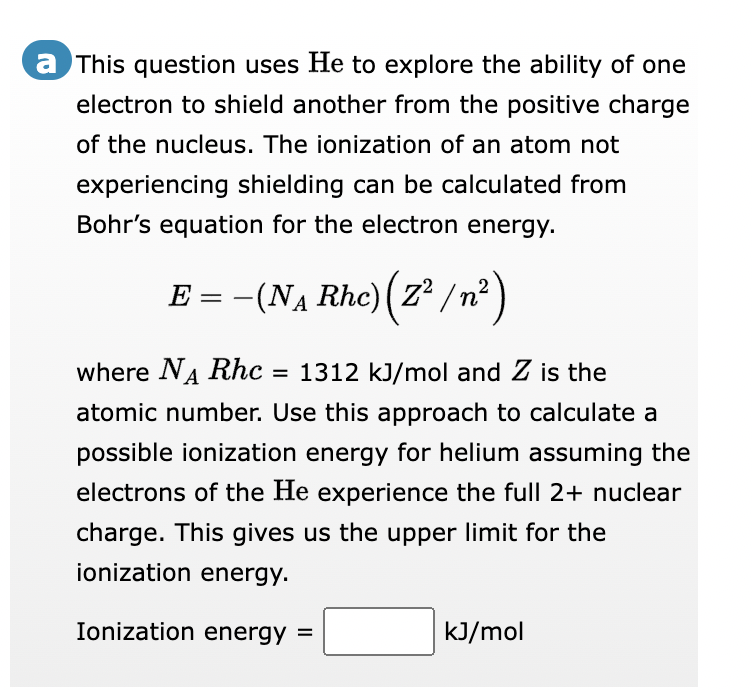a This question uses He to explore the ability of one electron to shield another from the positive charge of the nucleus. The ionization of an atom not experiencing shielding can be calculated from Bohr's equation for the electron energy. E = −(N₁ Rhc) (Z² / n²) where N₁ Rhc = 1312 kJ/mol and Z is the atomic number. Use this approach to calculate a possible ionization energy for helium assuming the electrons of the He experience the full 2+ nuclear charge. This gives us the upper limit for the ionization energy. Ionization energy = kJ/mol
a This question uses He to explore the ability of one electron to shield another from the positive charge of the nucleus. The ionization of an atom not experiencing shielding can be calculated from Bohr's equation for the electron energy. E = −(N₁ Rhc) (Z² / n²) where N₁ Rhc = 1312 kJ/mol and Z is the atomic number. Use this approach to calculate a possible ionization energy for helium assuming the electrons of the He experience the full 2+ nuclear charge. This gives us the upper limit for the ionization energy. Ionization energy = kJ/mol
Chapter3: Electronic Structure And The Periodic Law
Section: Chapter Questions
Problem 3.75E
Related questions
Question

Transcribed Image Text:a This question uses He to explore the ability of one
electron to shield another from the positive charge
of the nucleus. The ionization of an atom not
experiencing shielding can be calculated from
Bohr's equation for the electron energy.
E =
- (N₁Rhc) (Z²/n²
where N₁ Rhc = 1312 kJ/mol and Z is the
atomic number. Use this approach to calculate a
possible ionization energy for helium assuming the
electrons of the He experience the full 2+ nuclear
charge. This gives us the upper limit for the
ionization energy.
Ionization energy =
kJ/mol
Expert Solution
This question has been solved!
Explore an expertly crafted, step-by-step solution for a thorough understanding of key concepts.
This is a popular solution!
Trending now
This is a popular solution!
Step by step
Solved in 2 steps

Knowledge Booster
Learn more about
Need a deep-dive on the concept behind this application? Look no further. Learn more about this topic, chemistry and related others by exploring similar questions and additional content below.Recommended textbooks for you


Chemistry for Today: General, Organic, and Bioche…
Chemistry
ISBN:
9781305960060
Author:
Spencer L. Seager, Michael R. Slabaugh, Maren S. Hansen
Publisher:
Cengage Learning

Chemistry by OpenStax (2015-05-04)
Chemistry
ISBN:
9781938168390
Author:
Klaus Theopold, Richard H Langley, Paul Flowers, William R. Robinson, Mark Blaser
Publisher:
OpenStax


Chemistry for Today: General, Organic, and Bioche…
Chemistry
ISBN:
9781305960060
Author:
Spencer L. Seager, Michael R. Slabaugh, Maren S. Hansen
Publisher:
Cengage Learning

Chemistry by OpenStax (2015-05-04)
Chemistry
ISBN:
9781938168390
Author:
Klaus Theopold, Richard H Langley, Paul Flowers, William R. Robinson, Mark Blaser
Publisher:
OpenStax

Chemistry: Matter and Change
Chemistry
ISBN:
9780078746376
Author:
Dinah Zike, Laurel Dingrando, Nicholas Hainen, Cheryl Wistrom
Publisher:
Glencoe/McGraw-Hill School Pub Co

Introductory Chemistry: A Foundation
Chemistry
ISBN:
9781337399425
Author:
Steven S. Zumdahl, Donald J. DeCoste
Publisher:
Cengage Learning

Principles of Modern Chemistry
Chemistry
ISBN:
9781305079113
Author:
David W. Oxtoby, H. Pat Gillis, Laurie J. Butler
Publisher:
Cengage Learning